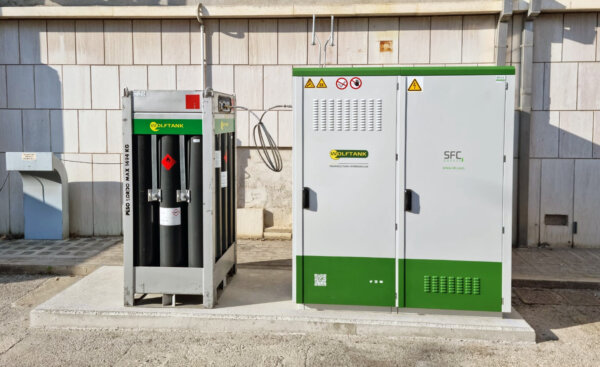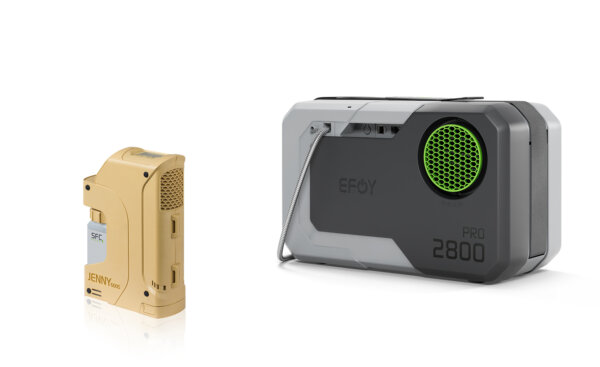29 Aug 2022

Climate-neutral, uninterruptible and flexible – EFOY fuel cells make all the difference and can be used in stationary or mobile situations as a vital source of energy in the event of emergency.
A minute is an eternity. Every minute of every day, around 210 million emails are sent and almost 600 new websites published. In 1985, Marita Koch, sprinted 400 meters in just 48 seconds (the current world record) and a woodpecker strikes a tree trunk with its beak more than 1,000 times per minute. A minute can be an eternity; it is simply a question of perspective. Especially when it really matters. A diesel generator takes a minute or more to take over the emergency power supply for critical infrastructure in the event of disaster – an eternity.
In the case of major crises resulting from floods, hurricanes or earthquakes, emergency services need to gain a rapid overview of the situation and gather information. Communication is a vital factor in the success of effective on-the-spot relief efforts. But disasters are often accompanied by power outages or emergency services have to operate in regions far from the electricity grid. A rapid, efficient and continuous power supply is essential. For emergency service personnel, hydrogen and fuel cell technology provides new opportunities and numerous benefits for a reliable source of power during deployment.

EFOY H₂Cabinet with extensive hydrogen reserves at Wolftank Group.
Photo Credit: Wolftank Group | wolftank.com
Uninterruptable, climate-neutral power supply.This is not a distant vision of the future or a scientific concept. Hydrogen fuel cells such as EFOY Hydrogen from SFC Energy are already being used as a stationary (back-up) power supply in numerous locations. The fuel cell modules switch on automatically, taking over the load as an auxiliary power unit no later than 20 seconds after an outage. In the case of H₂Genset, a mobile power generator operated by hydrogen, SFC Energy also enables emergency services and blue light organizations to be deployed more flexibly. Both these power supply solutions, whether stationary or mobile, also have one thing in common: they do not emit any CO₂ during operation, unlike diesel generators. The power supply is entirely climate-neutral, using hydrogen fuel cell technology in the form of EFOY Hydrogen. EFOY Hydrogen fuel cells are based on PEM (polymer electrolyte membrane) technology. They produce electricity from hydrogen, supplemented by oxygen from the air. They convert hydrogen directly into electricity. The only by-products are water vapor and waste heat. For example, a five kilowatt (kW) hydrogen fuel cell energy solution uses up to 45.6 tonnes less CO₂ than a conventional diesel generator at an assumed annual demand of 43,800 kilowatt hours (kWh). This is the same as driving a diesel-powered passenger car around 250,000 kilometers.
Another benefit of fuel cells is low maintenance. They have far fewer moving parts than diesel generators, which minimizes wear and maximizes the life cycle of the units. Thanks to their extended maintenance intervals and uninterrupted takeover of the power supply, fuel cells are the ideal solution for operating a wide range of end devices or entire systems independently, reliably and emission-free for several days. They are much quieter and can even be used in ecologically sensitive areas such as nature reserves thanks to climate-neutral power generation. In the case of diesel units, storing the fossil fuel is also problematic, in addition to damaging CO₂ and particulate emissions. The diesel component, paraffin, can form flakes over time, even at low temperatures, which may lead to blockages in the generator’s pipes, filters and pumps. This is not the case with EFOY Hydrogen. It is extremely efficient, even under the harshest environmental and weather conditions.
Numerous applications. The possible uses of EFOY Hydrogen solutions are just as numerous as their benefits. Safety-relevant applications such as cell phone networks, as well as energy, gas and water supply, for example, are just as much a part of the critical infrastructure as the digital radios of public safety authorities and organizations (BOS). This is a perfect example of remote back-up and emergency power supply for (semi) stationary systems. In the event of an extended power outage, regional and municipal authorities must ensure the operation of critical systems for at least 72 hours. Hydrogen fuel cell solutions are already being used to reinforce the power supply to the BOS digital radio network.
However, BOS staff must not only be able to access a reliable power supply in the event of an emergency. Even in everyday threatening situations, it is important to be able to operate rapidly and efficiently on site. Modern systems therefore need an alternative power supply in order to be able to exploit the full potential of their digital tools without any restrictions. Fuel cells are also suitable for these applications.
Increased flexibility thanks to mobile, portable solutions. SFC Energy jointly developed H₂Genset with its cooperation partners, Test-Fuchs GmbH and Auto AG Group. It is a hydrogen-based power generator in the form of a trailer solution with road approval that can be flexibly and quickly transported to any location. H₂Genset allows the partners to primarily appeal to user industries that previously relied on diesel generators for their power supply. As well as the above-mentioned emergency services and blue light organizations, this solution is also suitable for outdoor festivals and large construction sites, where it can supply green power to various end devices such as surveillance systems and lighting.
Portable EFOY fuel cells are another clever addition to the mobile H₂Genset. These small, light and flexible power supply solutions reduce the overall battery weight by up to 80 percent. This is a strong argument for emergency service personnel in the field, who not only have to operate away from the conventional power grid, but often also in rough terrain. Mobile location maps, GPS trackers, drones and multifunctional handheld devices have long been part of emergency teams’ everyday kit, supplementing their portfolio of essential tools. At the same time, electronic end devices create increased demand for power. EFOY fuel cells can reliably cover this and, in conjunction with batteries, enable extended deployments and improved safety for emergency service personnel.

Portable, mobile fuel cell solutions from SFC Energy fueled by methanol – SFC JENNY 600S and the EFOY Pro range.
The European Union has set a goal of becoming climate-neutral by the year 2050. There is no doubt that the energy landscape of the future must and will be climate-neutral and decentralized. To achieve this, CO₂ emissions must be reduced by well in excess of 90 percent, and gaseous, de-carbonized energy sources and raw materials used. CO₂-neutral hydrogen to power fuel cells paves the way for an emission-free, climate-neutral future. SFC Energy is accompanying emergency services, blue light organizations and a number of other application industries on this journey. It is important to accelerate this process in order to quickly achieve the goal of climate neutrality. Because not everything in the distant future is an eternity away.
We use cookies to provide you with an optimal website experience. This includes cookies that are necessary for the operation of the site, as well as cookies that are only used for anonymous statistical purposes. All information on cookies can be found in our data protection declaration, and in the imprint.
Required Statistics
